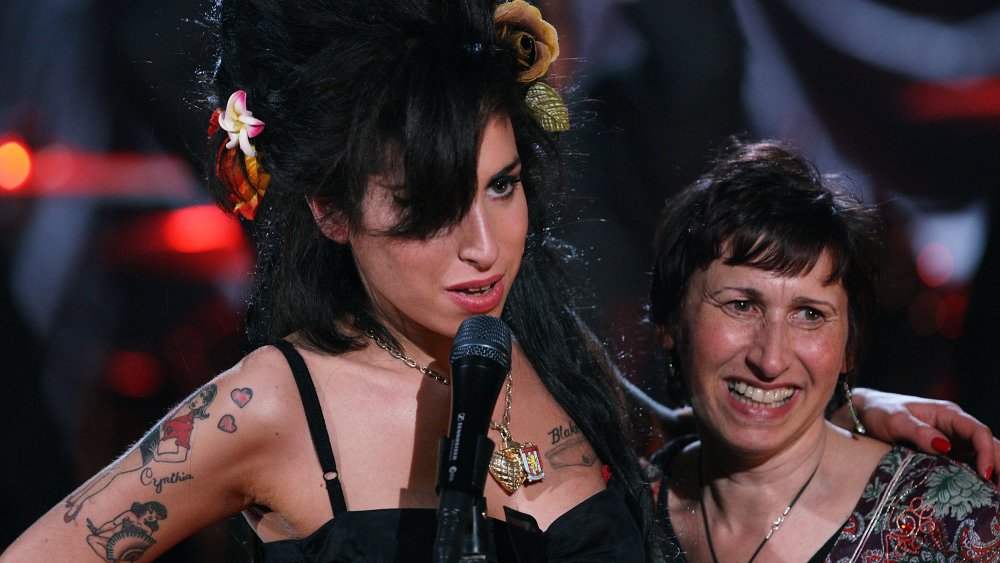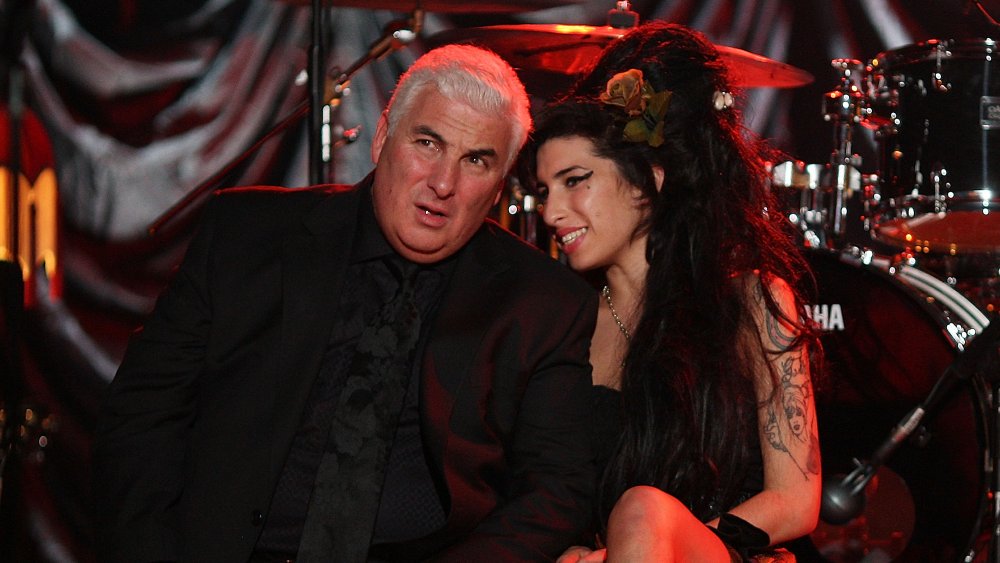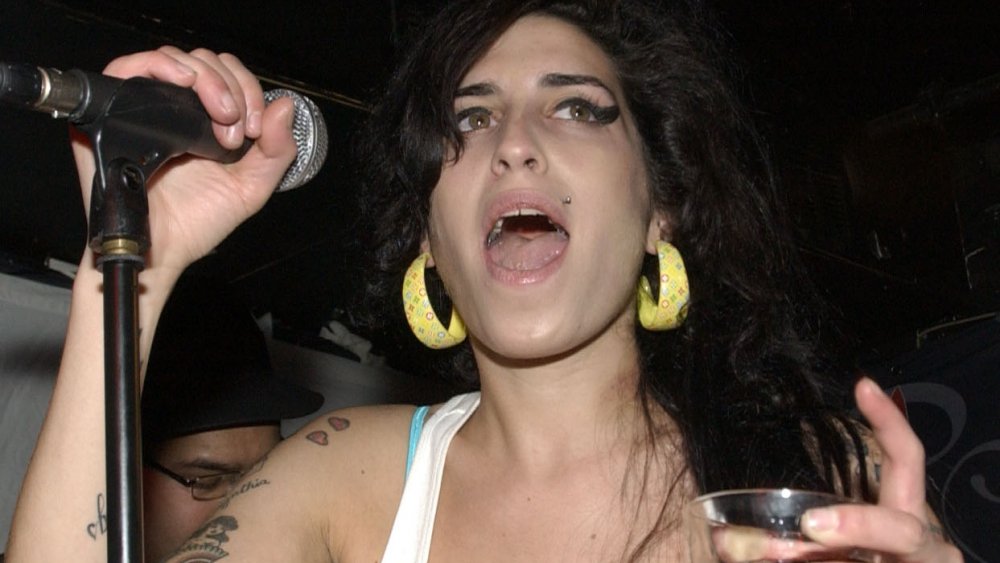The Tragic Real-Life Story Of Amy Winehouse
If you've ever heard Amy Winehouse sing, there's a good chance you can hear her voice in your head whenever her name is mentioned. Winehouse's extraordinary, powerful contralto was so unique that Classic FM tells us the legendary Tony Bennett once described her as "one of the finest jazz singers he'd ever heard," and classic soprano Catherine Bott has said she's "one of those voices that's instantly recognizable." The artist's songs certainly matched her pipes and her distinctive image. From "Back to Black" and "Tears Dry on Their Own" to her feisty yet tragic signature tune, "Rehab," her musical output was full of soul and esteemed by both professionals and the public.
Unfortunately, talented as she was, Winehouse's private life was as troubled as her music game was strong. She was haunted by personal demons and the tabloid press alike, and as her fame rose, her life started an intense downward spiral that she was ultimately unable to correct before it was too late. Today, we take a look at one of the most heartbreaking members of the "27 Club." This is the tragic real-life story of Amy Winehouse.
Amy Winehouse's early troubles
Amy Winehouse was talented at a young age, but unfortunately, the first signs of the various troubles that would plague her adulthood were also present. As The Guardian and Biography tell us, Winehouse was born in 1983 to cab driver Mitch Winehouse and pharmacist Janis Winehouse, and her childhood was full of music due to the family being full of jazz musicians. She was exposed to many different musical styles, and by the time she was ten, she was even a part of a Salt-N-Pepa-influenced rap band, Sweet 'n Sour.
In 1996, a 12-year-old Winehouse managed to get a place at the prestigious Sylvia Young Theatre School. However, she was kicked out at 16. It appears that her rebellious streak may have been raising its head by this point, as the reason for expulsion was that young Winehouse was "not applying herself" and ... uh, had dared to pierce her nose. To be fair, if she got trouble for that, the school doesn't really sound like the best place for an aspiring pop star, especially one with Winehouse's aesthetic leanings.
Amy Winehouse lost her anchor
Amy Winehouse was a huge fan of body ink, and one of her most prominent tattoos was an arm piece picturing a crude pin-up girl surrounded with hearts and the text "Cynthia." As Birmingham Mail tells us, this wasn't just some random walk-in piece. It's a special tribute to Winehouse's grandmother, Cynthia, and she designed it in collaboration with tattoo artist Henry Hate, who made the deliberately crude piece with zero idea that it would soon become one of the most recognizable tattoo designs in the world. Hate gets the occasional request to tattoo the same design on other people, but he always refuses out of respect to Winehouse and the tattoo's original meaning.
Winehouse was extremely close with her grandmother, who was also a singer and highly supportive of her granddaughter's artistic aspirations. According to NME, Winehouse's first manager, Nick Shymansky, considered Cynthia to be the singer's "guardian," and both he and Winehouse's father believe that Cynthia's death was the event that triggered the artist's downward spiral.
She really tried to say 'yes' to rehab
Amy Winehouse's "Rehab" is notorious for its defiant chorus, which states, "They tried to make me go to rehab, I said, no, no, no." The lyrics then comment that the singer's dad thinks she's fine, so whoever's trying to make her spend a stint in residential rehabilitation has another thing coming. These lines are based on a real incident.
As NME and Deutsche Welle tell us, Winehouse's substance abuse started to spiral out of control around the time her grandmother became deathly ill in early 2005. What's more, the bulimia she'd quietly struggled with as a teen made a comeback. All of this — along with a dash of relationship drama with on-again, off-again boyfriend Blake Fielder-Civil — made things so bad that her manager, Nick Shymansky, tried his best to convince Winehouse to go to rehab and sort things out.
She was fine with the idea, and everything was in order, but she wanted her father to back up her attempt to get sober. And Mitch Winehouse promised Shymansky to tell his daughter that the rehab plan was great, but when he actually saw her ... well, you know how the song goes. This incident has been described as Winehouse's last real chance of tackling her issues before becoming a sought-after superstar made it doubly more difficult. And while The Guardian tells us she eventually did give rehab a shot in 2008, it obviously turned out to be too late.
She was in a rough relationship
As The Daily Beast tells us, Amy Winehouse had a famous — and famously turbulent — love affair with Blake Fielder-Civil. They started dating in 2005, which also marked the start of Winehouse's metamorphosis from the comparatively conventional look of her jazzy Frank era to her famous tattoos, winged eyeliner and beehive hairdo. Fielder-Civil fully admits he was the one who introduced the singer to "heroin, crack cocaine, and self-harming," and though he's said he feels "more than guilty," it didn't make the pair's relationship any less difficult. They broke up, got together, and broke up again. They got married and had a divorce. At least once, they fought so badly that they were reportedly "covered with blood and bruises." Oh, and at the time Winehouse made her breakthrough and rose to the upper echelons of pop, Fielder-Civil was in prison for assault. When she died in 2011, he was in prison again, this time for attempted robbery and possession of a fake gun.
Yet despite the red flags that were scattered liberally around their entire relationship, Winehouse always seemed to consider Fielder-Civil as something of a muse. Even during his worst troubles, she showed public support for him several times, and she famously boasted a tattoo of a pocket that said "Blake's" near her heart.
Amy Winehouse's troubles with the law
Amy Winehouse did more than her share of walking on the wild side, so it's not exactly a shock that she had a few run-ins with the police over the years. A lot of this unwelcome attention from the officials seems to have coincided with the turbulent years after Back to Black exploded and propelled her to superstardom, and tragically, it all seems to be in connection with her issues with substance abuse. The Guardian reports that in 2007, Winehouse was arrested in Norway and spent the night in custody for cannabis possession. CNN notes that this wasn't her only arrest that year, as she was also briefly arrested due to "a case involving her husband," Blake Fielder-Civil.
According to the Los Angeles Times, Winehouse's troubles with the law continued in 2008, when she was arrested for allegedly assaulting someone outside a bar in London. As The Guardian tells us, there was another assault allegation against her that year, along with an incident that saw her arrested for "alleged drug offenses."
Amy Winehouse's struggle with addiction
Everyone who's even passingly familiar with Amy Winehouse's story knows that its arguably most tragic aspect was her long-running struggle with addiction. According to Deutsche Welle, Winehouse started drinking heavily around the time she gained notoriety, possibly as a method to deal with the pressures of fame. She met her future ex-husband and noted heroin addict Blake Fielder-Civil during one of her nights out, and eventually, her excesses started involving drugs as well.
By 2009, Winehouse's addictions started to severely affect both her voice and her career, and she was known to appear visibly drunk on stage. The crowds started booing and concerts were canceled, and though Winehouse's representatives attributed these bumps in the road to "health reasons," her troubles with alcohol were obvious to pretty much everyone. Unfortunately, she was unable to correct the course. While The Guardian tells us that in 2008, she finally made that much-needed trip to rehab she so resisted in her most famous song, the effects didn't last. It was alcohol that ultimately killed her in 2011, at just 27 years old.
The brain damage theory
On paper, Amy Winehouse's tragic tale of fame, addiction, and early death seems like a fairly straightforward story, but there just might be more to the tale than we know. Asif Kapadia, the director of the Oscar-winning documentary Amy, thinks that the artist may have suffered from brain damage that, as he put it, prevented her from "thinking straight."
Kapadia bases his theory on a claim that Winehouse had a number of overdoses and seizures during her years of substance abuse, but he's not the first person to speculate on the potential damage to the singer's brain. In 2008, Welt reported that medical professionals had warned Winehouse that another drug binge might actually kill her and that several doctors were genuinely concerned that the vast amount of drugs she was taking could leave her with brain damage. Then again, the media wrote all sorts of less than delightful things about the poor singer at the time, so who knows what the truth is?
The singer had some violent tendencies
Amy Winehouse might not come across as a particularly violent person, unless you count her tragically famous self-destructive tendencies. Even so, there was a dark period of her life where she garnered unfortunate attention for (allegedly) assaulting multiple fans. According to CNN, when Winehouse performed in front of 80,000 people at the Glastonbury Festival in 2008, she allegedly punched someone in the front row. In all fairness, it must be noted that the festival's organizer said she did this because said someone had grabbed her breasts, which, as you know, is a huge no-no.
However, this wasn't Winehouse's last reported punching incident. In 2009, The Guardian wrote that the singer was in court for allegedly punching a dancer in the eye at the backstage of a summer ball after said dancer had asked for a selfie with her. Later that year, Rolling Stone reported that Winehouse attacked a theater owner who was trying to stop her from making a scene at a performance of Cinderella.
Tabloid troubles
It's probably fair to say that most British celebrities of note have to struggle with unwanted attention from the country's tabloids at some point in their careers. However, as NPR notes, Amy Winehouse had to play the yellow press game on hard mode. Much of this was because the media field was shifting at the time, and as a troubled famous person with the occasional public meltdown in an era when things like YouTube and Facebook were starting to really hit it big, she was in the worst possible place at the worst possible time when it came to unwanted media attention.
People couldn't get enough of the whole "celebrity having difficulties" thing that Winehouse pretty much introduced to the digital age, and because her face attached to a cover story was basically a license to print money, she was constantly hounded by the paparazzi. Asif Kapadia, director of the documentary Amy, says that the singer was essentially trapped in a situation where almost everybody close to her had a media deal of some sort, leaving everyone looking out for their own interests and her "getting more and more lost" in the middle of it all.
The disastrous comeback tour
Some artists seem completely doomed, and their career seems dead in the water. Then, they unexpectedly get their act together and re-emerge in a glorious comeback that reminds everyone of their talent and glory. Unfortunately, not everyone can pull a Robert Downey Jr. because it requires the artist to actually have spent some time wrestling their demons into submission. As The Guardian reports, Amy Winehouse certainly hadn't accomplished this when she embarked on her comeback tour in 2011, and as a result, her phoenix didn't so much rise from the ashes as it completely failed to ignite and settled to roll in the ashes some more.
Winehouse had largely avoided the stage for the previous two years, so her European tour had all the makings of a grand comeback. But when she entered the stage in Belgrade, Serbia, it was soon evident this comeback was anything but glorious. It was, however, a painful demonstration that her addiction issues were far from behind her. Winehouse randomly stopped a song halfway through to introduce the band, only to barely remember their names. She suddenly made a freaked-out backup dancer to take over the vocals on "Valerie." She randomly decided to remove a shoe. All in all, the media considered the concert the worst in Belgrade's history, and even the country's minister of defense calling it "a huge shame and a disappointment." The rest of the tour was promptly canceled.
The death of Amy Winehouse
After years of excruciatingly public struggles with drugs, alcohol and seemingly every bad thing they could happen to a person, Amy Winehouse's life came to an end on July 23, 2011. Winehouse was only 27 years old when she died, and her cause of death was "accidental alcohol poisoning." According to The Guardian, she'd developed a pattern where she stayed sober for weeks, then fell off the wagon with a drinking binge. Evidently, her body simply couldn't handle her last binge anymore. As a result, she was found lifeless in her room the next morning, with a staggering blood alcohol level of 0.416 at the time of death.
It should be stated that we can actually be pretty sure about the "accidental" part in her cause of death. As TNT Magazine reports, Winehouse specifically told her doctor shortly before her death that she didn't wish to die, and that she was "looking forward to the future." Unfortunately for her, the future never came.
Amy Winehouse struggled with an eating disorder
What really killed Amy Winehouse? According to The Guardian, her untimely demise in 2011 was ruled "death by misadventure" due to drinking so much alcohol that it poisoned her. However, her brother, Alex Winehouse, put forward an alternate theory in 2013. He doesn't exactly contest the coroner or anything, and he fully admits that his famous sister's vast drug and alcohol levels did no favors to her lifespan. However, Alex feels that the thing that contributed most to Amy's extremely untimely death was an eating disorder rather than narcotic substances.
Amy Winehouse struggled with bulimia for years, and her brother feels that her physique was significantly weakened by the periods of extreme overeating and the following bouts of self-imposed vomiting and depression that are typical of the condition. Alex Winehouse says that the condition stemmed from the singer's teenage years, when she had a group of friends who would all "put loads of rich sauces on their food, scarf it down, and throw it up." He says that most of them eventually stopped, but the condition stuck with his sister, and since she wasn't prepared to really talk about it, her eating disorder was a pretty hard issue to bring up. Still, Alex — who co-runs the Amy Winehouse Foundation in his sister's honor — decided to breach the subject after his sister's death in order to raise awareness for the condition.












